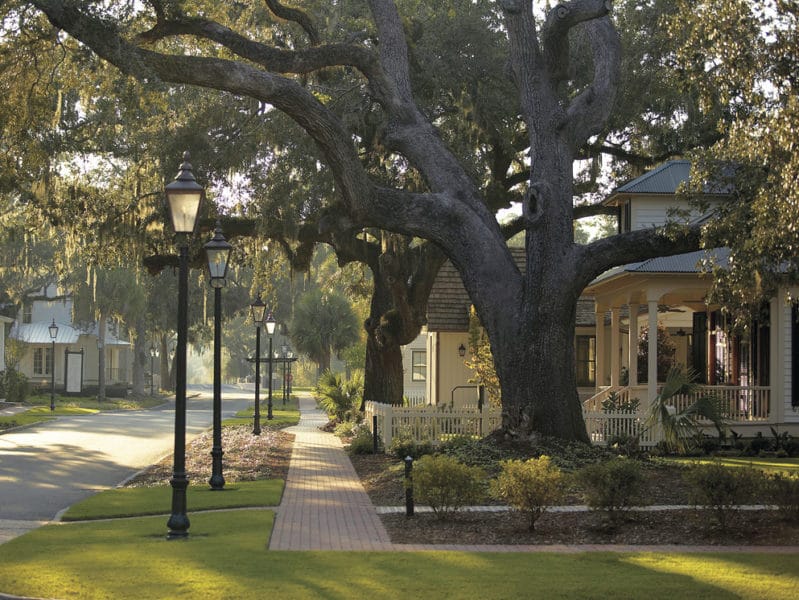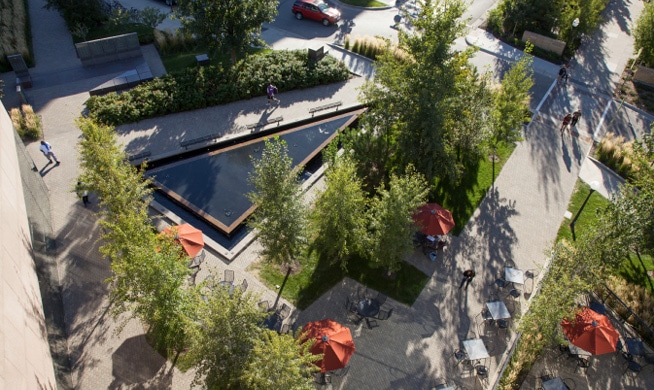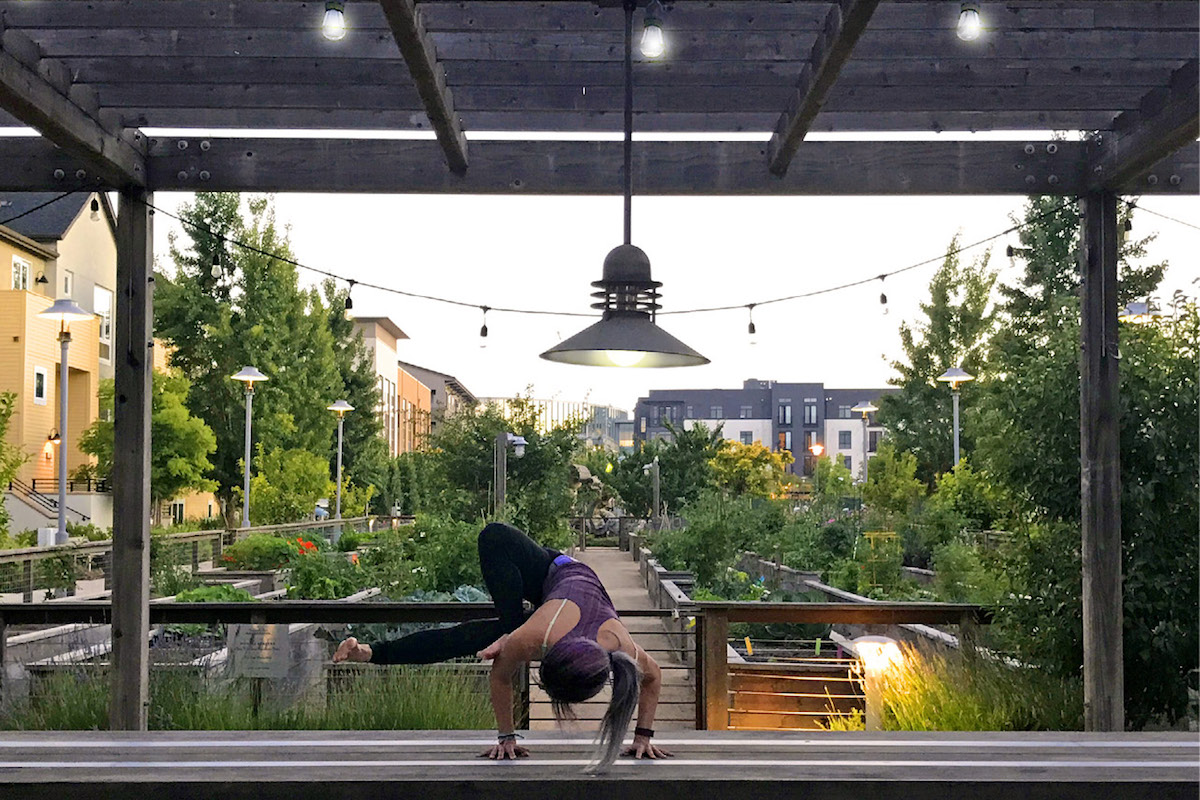Story at a glance:
- Hart Howerton is transforming communities and designing healthy places.
- Nine factors were identified by researchers at UVA in collaboration with Hart Howerton as part of the Healthy Neighborhoods initiative.
- The Edge-on-Hudson project is a great example of the principles in action and asks a simple question: How do you value your time?
When Jim Tinson of architecture firm Hart Howerton sits at his desk and looks out at the Hudson River, he thinks about how the region is not just a smart location for real estate development, but one that’s also loaded with opportunity to build a community the people there can be proud of.
In particular, he’s thinking about Hart Howerton’s current Edge-on-Hudson project, 25 miles from New York City.
As CEO of Hart Howerton—a global team of planners, architects, landscape architects, and interior designers—he’s committed to implementing projects that result in healthy places.
“Can we, in this case, come in and anchor the property with a health and wellness component that becomes not just an amenity, but actually becomes the core?”
The answer is a resounding yes.
The ongoing Edge-on-Hudson project is just one of many the firm has in progress. It’s all part of the Healthy Neighborhoods initiative, which identifies nine principles in designing healthy communities. In 2012, Hart Howerton and the University of Virginia Center for Design and Health partnered to study these principles, ranging from smart location and integrated nature to mixed uses, access to healthy food, and sustainable development.

Photo courtesy of Hart Howerton
The Principles of Healthy Design

Palmetto Bluff is a finished example of Hart Howerton’s healthy design principles in action. Photo courtesy of Hart Howerton
These nine factors were identified by researchers at UVA in collaboration with Hart Howerton as part of the Healthy Neighborhoods initiative:
Smart location
Integrate nature
Mix uses
Mixed housing types / Mixed income / Multi-generational
Circulation alternatives
Social connections to instill pride of place
Provide access to healthy foods
Lifelong learning and teaching
Sustainable development
“The places that stand the test of time are places that resonate on all of these levels,” Tinson says.
Why It Matters
Tinson says it’s principles like these that help the company continue to design for human experience, taking into account each community’s needs.
“The cornerstone is creating a healthy environment for people to thrive and flourish—those are the real estate developments that are most attractive. They can’t just be replicated by the next subdivision down the street because you tapped into the DNA of a place,” he says.
While the mission at Hart Howerton has evolved, the heart of the company has always centered around these notions.
“It goes back to when Robert Lamb Hart founded the practice in the late ’60s, that the ways people are spending time in places, who they’re choosing to spend time with, and making a choice to be in one particular space versus another are rooted in the same aspirations for the qualities of the places we’re designing,” says Tim McCarthy, managing principal for Hart Howerton.
McCarthy says Edge-on-Hudson is a great example of putting the principles in action and asks a simple a question—how do you value your time? While property values in Brooklyn are through the roof, you’re still 40 minutes away from Midtown by car or Subway. The team at Hart Howerton asked, why not look north instead? Just 25 miles from New York City, you could be relaxing on the Hudson River and interacting with your neighbors in Sleepy Hollow every night. And thus the Edge-on-Hudson project was born.
The development was a no-brainer when you think about it, as it’s close to nature (you can see both the river and the Palisades) as well as the city (you can see Manhattan and also have easy train access). It’s also built around the health and wellness principle, with plentiful waterfront programming and Exhale Spa as an anchor near the park.
“You’re walking to and from the train and then you’re interacting with the community,” McCarthy says, adding that they’re introducing commercial property that complements the existing community’s already thriving establishments. “What does that mean to return to somebody a quality of life you wouldn’t have thought was possible within a 45-minute train ride?”
Education is another key principle at play here.
“One of the first things we did here was work with the development team to secure a grant from the State of New York to put in an educational component on the walkway that celebrates the history of the site and the Hudson River,” Tinson says. A 3D map on the ground will invite you to study where you are in the regional ecosystem as you stroll through the park. “It’s using these principles to bring life to a place and then ultimately realizing that in everything you do, your first responsibility is shaping a setting for life to happen,” Tinson says. “The life you’re shaping is built around these principles.”
The Evolution of Building Better

Photo courtesy of Hart Howerton
Designing healthier places starts at a societal level.
“I think people are a little bit smarter than the CIAM days of the 1930s when architects had the solution for utopia and things like Broadacre City,” McCarthy says. “This time around, architects are approaching it in a much more integrated, holistic way.”
Now architects like those at Hart Howerton are engaging with professionals across backgrounds, from health care and policy to developers and people in finance, to ensure the healthiest overall community. “The built environments in which people grow up have huge impacts on the long-term health of people,” McCarthy says.
And the principles are working. At this point, there are clear, long-term health outcome improvements, McCarthy says, adding that teams are still working to prove the immediate financial benefits. While health care professionals and others agree it’s great to reduce the amount spent on treating chronic disease, short-term investors are more focused on getting a financial return in as little as five to seven years, so they may be less impressed about health impacts. “That 30-year conversation isn’t interesting until you can point to a bottom line,” McCarthy says.
But people are taking a long, hard look at where they work and live—and that does add up. McCarthy says more people seek healthy places, and sustainable communities and workplaces are a recruitment tool for employers. “People will pay a premium rent, and the developer is seeing the upside,” he says. Research shows happier employees equal increased productivity and reduced absenteeism. “All of those things are helping drive an ROI conversation about health.”
The big question arises when you have a new development—say 1,000 acres. What says you should build healthy? While McCarthy says a lot of people simply say “it’s the right thing to do,” it helps to have principles to point to why and how it works. Why should a developer come in and make sure there’s multiple modes of transportation available, for example? Why should they ensure there are bike trails, a local grocery store, a community garden, and access to local programming? Because building healthier is an investment, and aspects like these meet people’s physical and social needs. “You start to reduce depression and alleviate obesity and other chronic conditions that are a big deal.”
Palmetto Bluff is a finished example of the firm’s principles in action. Instead of designing large home lots where you don’t know your neighbor, this Hart Howerton project was built around a thriving village that integrates nature. The 18,000-acre barrier island surrounded by rivers and wildlife preserves in South Carolina is made up of four residential neighborhoods with more than 800 home sites, a spa, golf club, fitness center, pool, and tennis courts. Set in a protected pine forest, the center is a pedestrian scale village that resembles a historic coastal town. The village was the first thing Hart Howerton built there, and it fostered a sense of community where neighbors spent time on porches socializing again.
Healthy History

Photo courtesy of Hart Howerton
These principles are nothing new for Hart Howerton, though; they go back to the beginning when Hart founded the company. “Bob always said, ‘These aren’t new ideas. This is what I was talking about 50 years ago,’” Tinson says. “It was a small voice in the industry at the time, this idea about how you design complete environments, as we call it.”
Hart Howerton continues to take a whole systems approach, looking not at one building, but at the entire landscape. “At the end of the day, this creates healthier places—places that stimulate human activity and mind and body,” Tinson says.
When the firm partnered with UVA, they wanted to codify that thinking and help demonstrate the return on investment. Tinson says that while most of the principles are intuitive, it helps to be able to point to them as proof of what’s possible. Bringing in independent researchers who arrived at those same principles was validation. “That was rewarding and confirming.”
Tinson says this mindset weaves its way through each project they do. It begins with picking the proper site, continues through providing access to recreation and food options, looks at how to emphasize local tradition, and so forth. “What got all of us into this business to begin with is actually seeing people use and benefit from the places we create,” he says.
Tinson says each project Hart Howerton takes on is an opportunity for transformation that considers what made each community special in the first place. “Each one is shaped by the same vision, but each one is a very different program,” he says.
Recently, Tinson was visiting Hart Howerton’s Bay Meadows project in San Mateo, California. The 80-acre transit-oriented infill development on a former racetrack has been completely revolutionized.
“I’m sitting in that place and I’m watching a multi-generational, remarkably diverse population spilling out of a coffee shop and talking about the next restaurant that’s opening up and how they’re going to the farmers’ market,” he says. “Seeing it as a vibrant neighborhood, a place of employment and living, all of that coming together that was built on a vision that’s grounded on these principles—that’s pretty gratifying.”



